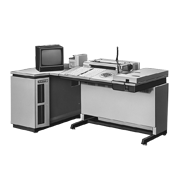A keyboard-less office computer featuring a unique book-panel pen input system.
In May 1976, Ricoh rolled out the PenCol DE5000, a computer that was easy to use for anyone, not just specialized operators. The office computer used floppy disks, which were a cutting-edge technology at the time, as for auxiliary storage, and it featured number keys and a unique pen input system that consisted of a book-sized panel board in place of a typewriter-like keyboard. Frequently used data parameters, such as the names of business partners or product names, were handwritten on the book panel, enabling unskilled workers to input and output data simply by touching the required item with a light pen. The PenCol DE5000 was jointly developed by Ricoh and Kanazawa’s Vantec.
Each page spread in the book panel had 432 entry spaces and holes, and inputs were made by pressing with a pen on the appropriate item. Each book had nine page spreads (18 pages), and books could be changed for different business processes. This simple operation function made the computer easily accessible for users not accustomed to typing on a keyboard. Along with the launch of the Ricoh PenCol, Ricoh systemized a number of formerly separate office business processes — micro devices (storage), ri-nack (search), ri-copy (copying), and ri-fax (communications) — and as a result the introduction of advanced business systems spread rapidly, particularly among small and medium-sized offices. The DE5000 was programmed in assembler, and it had IC storage elements with a total capacity of 16 kilobytes. When connected with the optional paper-tape punch / magnetic cassette tape unit, data could be created for computer processing while performing billing operations.


